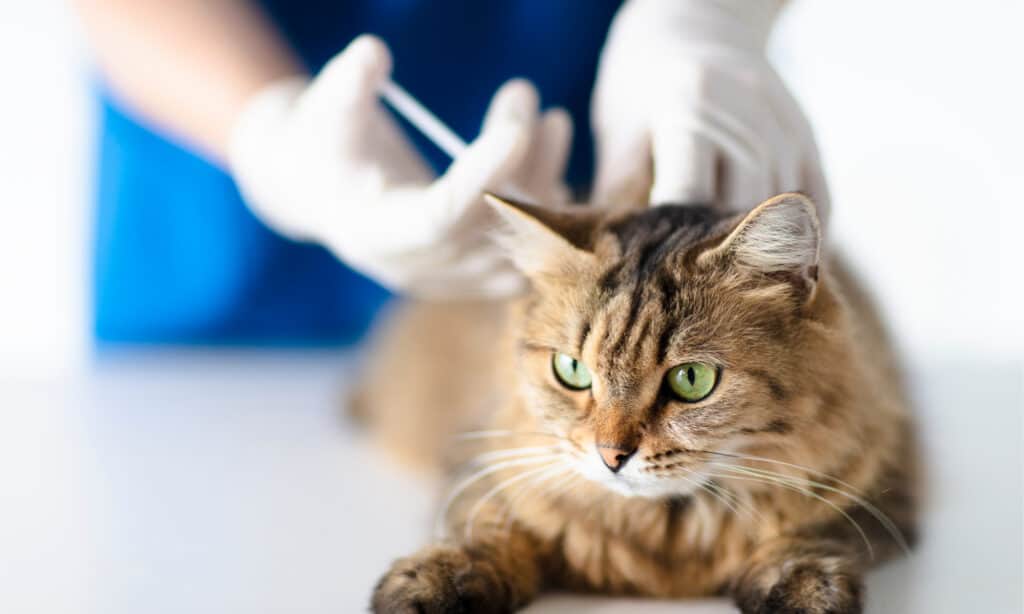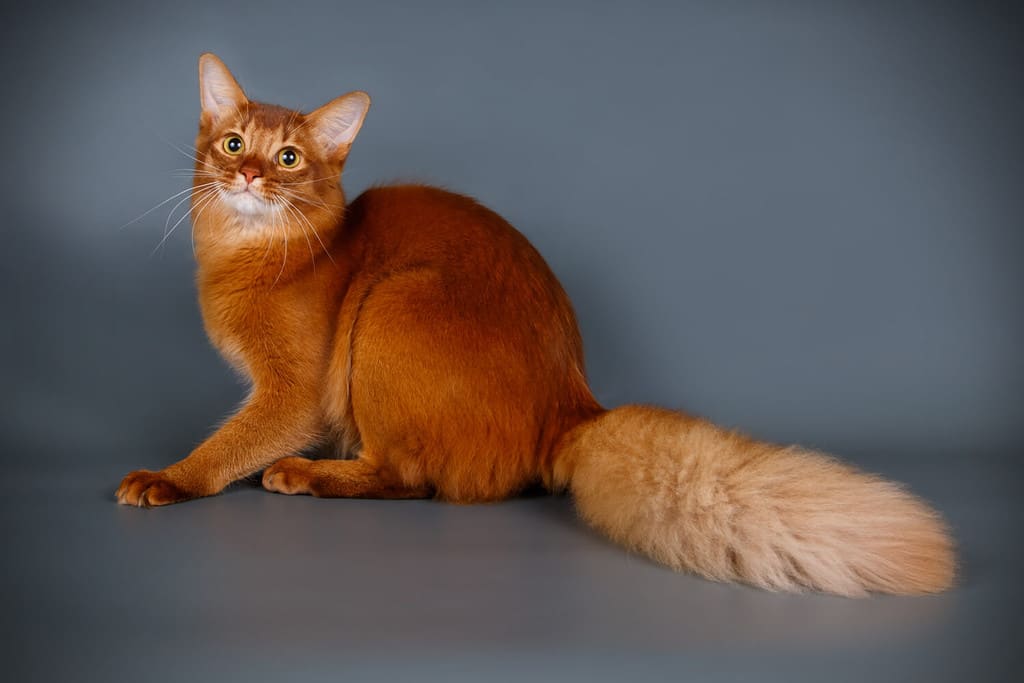If you’ve ever seen a Somali cat, you may be interested in purchasing one as a pet. These beautiful and regal cats have a reputation as a fun and energetic addition to the family. Today, we’ll discover Somali cat prices along with what factors influence the cost. First, let’s learn a bit about the breed.

Somali cats are lively and entertaining pets.
©dien/Shutterstock.com
A Brief History of the Somali Cat
The Somali cat breed began in the late 1800s to early 1900s when Abyssinian cat breeders discovered the long-haired variant. Some believe this was achieved by outcrossing to unrelated long-haired cats, though this has never been proven. Regardless of their origin, the Somali is a well-loved breed throughout the world. Despite the name, this breed did not originate in Somalia. Actually, the name is a play on words. The name Abyssinian comes from the former name of Ethiopia (Abyssinia). Somalia borders Ethiopia, thus breeders chose this name to establish a clear relation between the two breeds. Somalis were accepted in the show ring by both The International Cat Association and The Cat Fancier’s Association in 1979.
Somali Cat Description

Chocolate is a rare Somali cat color, which means they cost more.
©Sarah Newton/Shutterstock.com
By all appearances, the Somali is a semi-long-haired version of the Abyssinian. The Somali sports a plumed tail and fluffy ruff around the neck. Though they come in many colors, the most common is ruddy (brown) ticked tabby. Ticking is a result of some hairs in the coat having white tips, giving a speckled appearance to the coat. All Abyssinian and Somali cats have this ticked pattern. Other colors include red, tortoiseshell, sorrel (cinnamon), chocolate, blue, lilac, fawn, and cream. Any of these colors may also be combined with silver, which changes the undercoat to bright white. Depending on the registry, some colors are not accepted in shows. World Cat Congress organizes current information about approved colors and variants of many cat breeds, including Abyssinian and Somali cats.
Somalis, like their Abyssinian cousins, have large ears. Most have green or gold almond-shaped eyes. Except for around the neck and the fluffy tail, the Somali’s coat lies close to the skin and has a shiny appearance. They are well-muscled and very athletic.
Now that you know more about the incredible Somali cat, let’s learn about prices.
How Much Does a Somali Kitten Cost?

Consider choosing a reputable breeder for the purchase of a Somali kitten.
©nelik/Shutterstock.com
Somali cat prices range from $1,000 to $3,000 with the average at about $1,800 from a reputable and trusted breeder. You’re highly unlikely to find a purebred Somali cat in a shelter. Rarely, kitten mills may produce Somalis and may sell them at a lower price. However, purchasing from a kitten mill is not recommended. A reputable breed ensures the kittens they sell are healthy, while kitten mills care only about making money. Somalis from show-winning lines can increase the cost to $5,000!
If the price of a Somali kitten is out of your range, consider adopting a retiring breeding cat. These cats usually range in age from one to four years old. They still have plenty of years left to join your family and live the spoiled pet life! The cost of a retired Somali is typically about $200 to $500. The best part is these cats have already been fully vaccinated, spayed/neutered, and grown past the destructive kitten stage. Also, the breeder will be able to provide you with all the details about their personality in advance. This allows you to get a well-rounded cat suited to your family and lifestyle.
Other Factors That Influence the Purchase Price of a Somali Cat
Several characteristics may influence Somali cat prices. These factors include color, quality, and location. Breeders in places where few Somali kittens exist for sale may increase their prices due to supply/demand. The more rare the color, like chocolate ticked tabby, the higher the price. Somali cats are relatively rare in general, so expect to wait a while for your kitten, even once you find a breeder you trust.
Cost of Vaccination and Other Medical Expenses for Somali Cats

The cost of vaccines is important to know before getting a Somali cat.
©Tom Wang/Shutterstock.com
Vaccinations, deworming, heartworm/flea/tick prevention, and other medical expenses can raise the overall cost of your Somali cat. Veterinary care is essential to the health and well-being of your Somali. Let’s explore some of these additional costs.
Vaccines
Vaccinating a kitten starts at 6-8 weeks old and continues every 3-4 weeks until they are fully vaccinated at 15-18 weeks old. The average cost in the United States for this vaccination series is $150-$650 not including the cost of examination. Average examination costs range from $20-80. Some veterinarians require an exam every time your kitten gets a vaccine. Therefore, the cost of vaccinations for the first year of your Somali kitten’s life could reach nearly $1000. This is very important to remember before getting a cat or kitten. Vaccinations help prevent life-threatening diseases and some are required by law (such as Rabies vaccine) depending on where you live.
Deworming/Parasite Control
Though deworming your Somali kitten is relatively inexpensive at about $10-30 per treatment, the additional requirements for obtaining the medication may raise the price significantly. If your Somali must have a fecal examination before medication is prescribed, that costs anywhere from $20-100, depending on the veterinarian’s procedure. Most cats requiring deworming will need an initial fecal exam and a recheck test to ensure the parasites have been eliminated.
Heartworm, Flea, and Tick Prevention
Even if your Somali will spend 100% of their time indoors, they still risk becoming infested with fleas, ticks, or heartworms. Fleas and ticks can easily be carried indoors by you or other pets. Heartworms are carried by mosquitos, which can easily fly into your home and infect your cat. There is no cure for heartworm in cats. Protecting your Somali cat from these parasites increases their cost of care. Preventative medications such as Revolution Plus cost about $30 per month and cover all three parasites. Other products may be more or less expensive, but also more or less effective depending on where you live.
Cost of Food and Supplies for Somali Cats

Toys, treats, food, and other care items all contribute to the cost of a Somali cat.
©Oleksandr Volchanskyi/Shutterstock.com
Somali cats do not require a specialized diet, which helps keep the cost of feeding them fairly low. However, cheap cat food can be detrimental to your cat’s health. It’s important to learn what good quality cat food is and discuss options with your veterinarian to help keep your cat happy and healthy. The best cat food for your cat may be different from what’s best for another cat. Keep in mind that expensive doesn’t always mean good, either. Expect to spend anywhere from $10-60 a month on cat food.
Other supplies such as litter boxes, litter, treats, toys, a carrier, and more all add to the cost of your Somali cat, too. Expect to spend anywhere from $10-100 a month on additional supplies for your cat.
How Much Does It Cost to Insure a Somali Cat
Monthly pet insurance prices for Somali cats range anywhere from $10-200, depending on the company you choose. Pawlicy.com helps pet owners find an insurance policy that fits their budget and provides the coverage they want. Remember, most pet insurance companies don’t pay upfront — they reimburse you later up to a certain percentage. Research pet insurance carefully before buying!
The photo featured at the top of this post is © BIGANDT.COM/Shutterstock.com
Thank you for reading! Have some feedback for us? Contact the AZ Animals editorial team.







